[ad_1]
Artist Maisara Baroud lived in Gaza city with his small family in a large family home. Every morning, he would head to the Al-Aqsa University, where he was a lecturer in the faculty of Fine Arts. He returned home and spent his evenings in his studio, in the august company of books, papers, paints, canvases, and experiments. Until October 8, 2023.
A day after the Israel-Palestine war began, his private office was destroyed when the 12-storey Al Watan tower was levelled. The very next day, Israeli airstrikes reduced his family home to rubble. “I lost everything: a significant portion of my works, acquired pieces from artist friends, my studio with all my experiments, archives, and works accumulated over the past 30 years. I lost my tools, dozens of paintings, thousands of sketches, and an art library with over 3,000 books. I lost my small, private world, all my memories and belongings. I could save nothing,” says Baroud. Life as he knew it had changed, possibly forever.
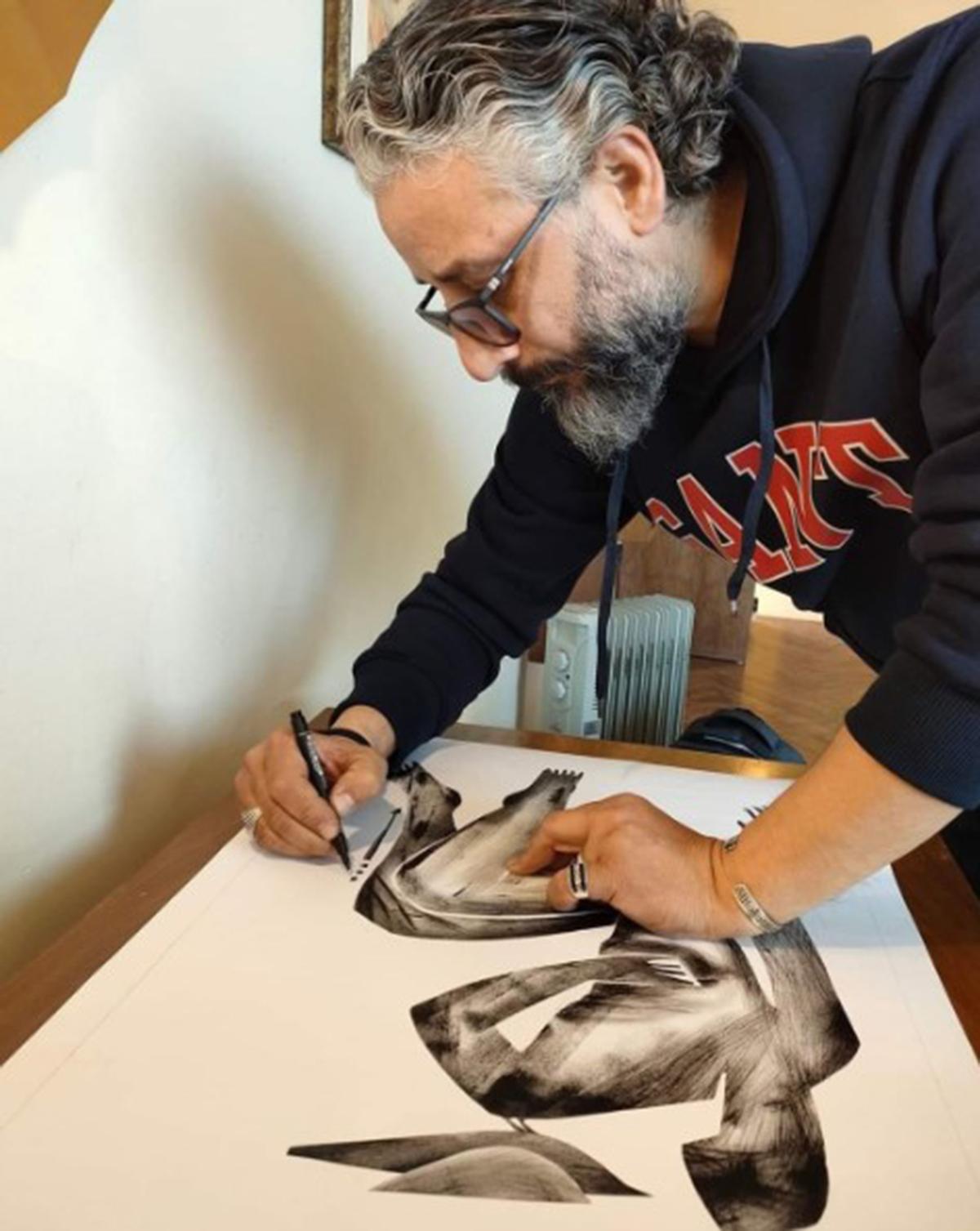
Maisara Baroud
| Photo Credit:
Courtesy @maisarart
Soon after, in an attempt to reassure his friends and students that he is alive, he started posting his ink drawings on social media every day. “While rockets, shells, and the machinery of destruction have ended all my future dreams, they could not take away my passion and love for drawing,” he asserts.
Aptly titled Still Alive, the collection — active even today — simply depicts day-to-day life in a Gaza splintered by war through sharp and direct line drawings, even as Baroud flees from relief camp to relief camp. At the time of writing this, Baroud is displaced in Deir al-Balah, and is living in a dilapidated building with “barely any walls”.
Baroud is one of many artists and creatives who steadily produce art in the face of conflict, defying real threats of censorship and life. Art that brews in conflict inevitably takes on many meanings and purposes; most often as powerful tools of resistance, awareness and documentation, and self-expression. More recently, his works were displayed on the walls of the Museum of Modern Art (MoMA) in New York, at the Venice Biennale (in collaboration with the Palestinian Museum in the U.S.), and at the Plaza Mora Palace in Venice under the title Strangers in Their Own Land.

Exodus No (14)
| Photo Credit:
Courtesy @maisarart
Songs of a conflict
Earlier this year, in Manipur, musician Akhu Chingangbam fashioned a makeshift studio at a relief camp in Phayeng, Imphal West, housing children from the Meitei community. They sang in unison: Often visited in my dream/My little hut by the hillside/Although burnt down to ashes/My little village by the hillside. Released on May 3, to mark one year of the ongoing ethnic conflict in the state, the song, titled ‘Chingyagi khangpokshang (Song from a relief camp)’, is a poignant memory of the life that was, with a clear message of hope and trust. The song has garnered more than 75,000 views on YouTube.

Akhu Chingangbam (third from right) with his band
| Photo Credit:
Special arrangement
“Before the crisis, Manipur was vibrant. After the pandemic, there was a palpable sense of hope, especially among the youth, with many music festivals. The past 17 months have put a complete halt on any activities,” says Chingangbam, frontrunner of rock band The Imphal Talkies. He also leads A Native Tongue Called Peace project, which documents Manipur’s musical legacy through children from different ethnic backgrounds, and supports an education project that helps children in relief camps to appear for their board exams. “A Native Tongue Called Peace was started in 2015 at a children’s shelter home in Imphal. There you will find a Naga and Kuki girl singing a Meiteilon song, a Meitei boy singing a Tangkhul song,” he says. “There was an organic exchange of culture between the children. I thought this could be a good model for Manipur — with peaceful coexistence.”
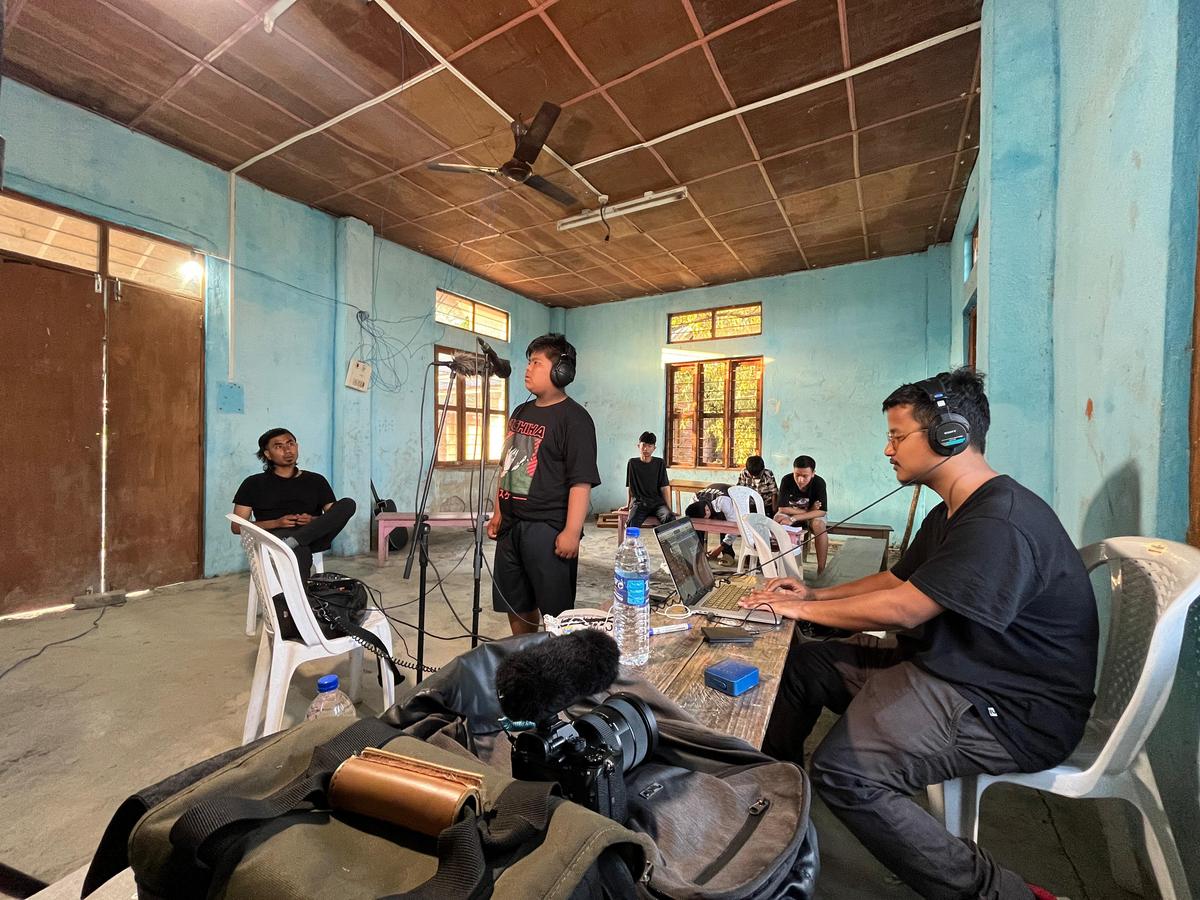
A boy sings at the makeshift studio in Phayeng
| Photo Credit:
Special arrangement
The musician sounds dejected as he speaks of his own practice. “None of us is in the mood to play, and make music now. Some musicians have even had to sell their instruments for money.” Even when friends and fellow musicians moved to other cities following the crisis and a rapidly crashing gig economy, Chingangbam felt he needed to stay back. He could not abandon his various social projects. But gig invitations from artist friends in cities like Delhi and Mumbai still flow in helping him take these songs and stories outside the state.
Amplifying their voices
Apart from fostering hope, art helps artists torn by conflict to imagine a different reality. For the last two decades, U.K.-based In Place of War has been able to create spaces and offer support to people using arts in conflict zones to make lasting social change. They work with a network of over 130 changemaker organisations in places facing varying degrees of conflict — from political oppression to a post-conflict scenario like that of Sudan. For instance, their project ‘Grrrl’ features women artists from various places of conflict who come together to form a music band, which tours the world on festival platforms. They performed at the closing ceremony of the 2022 Commonwealth Games in Australia. “This project gives women whose voices are often marginalised a chance to stand on a stage in front of thousands of people and share their stories using music — on their own terms and in their own words,” says CEO and creative director Ruth Daniel.
In places with no access to employment, art also becomes a tool to monetise. This is where platforms such as In Place of War come into play. “We have a global music industry advisory board with 25 big music companies from Spotify to RedBull helping to support what we do,” shares Daniel. “We have the #HackMusic catalyst fund that gives funding to grassroots music organisations, and for equipment to make music spaces. We also have a creative and social entrepreneurial programme that we have delivered in over 23 countries, by supporting everyone from fashion designers to artists and musicians.”
In this case, Ruth says that it is important to make a distinction between art that is created in conflict and outside of it. “When you are in the middle of a conflict, it is difficult to create unless it is a distraction or a form of therapy. If you then become a refugee and move away from conflict to create art that reflects on your experiences, that is one part that can be monetised.”
Dissent via samosa packets
Art born out of crises often shape-shifts into acts of resistance. U.K.-based Bangladeshi artist Sofia Karim’s idea of resistance art has risen through personal stories. “My uncle [renowned photojournalist and activist Shahidul Alam] was jailed in 2013, which was the turning point,” she says. He was jailed for 107 days on charges of “provocative statements” against the Information and Communications Technology Act of Bangladesh. Alam has also been on the forefront of the coverage surrounding the recent anti-government protests that toppled Bangladesh’s long-serving Prime Minister Sheikh Hasina.
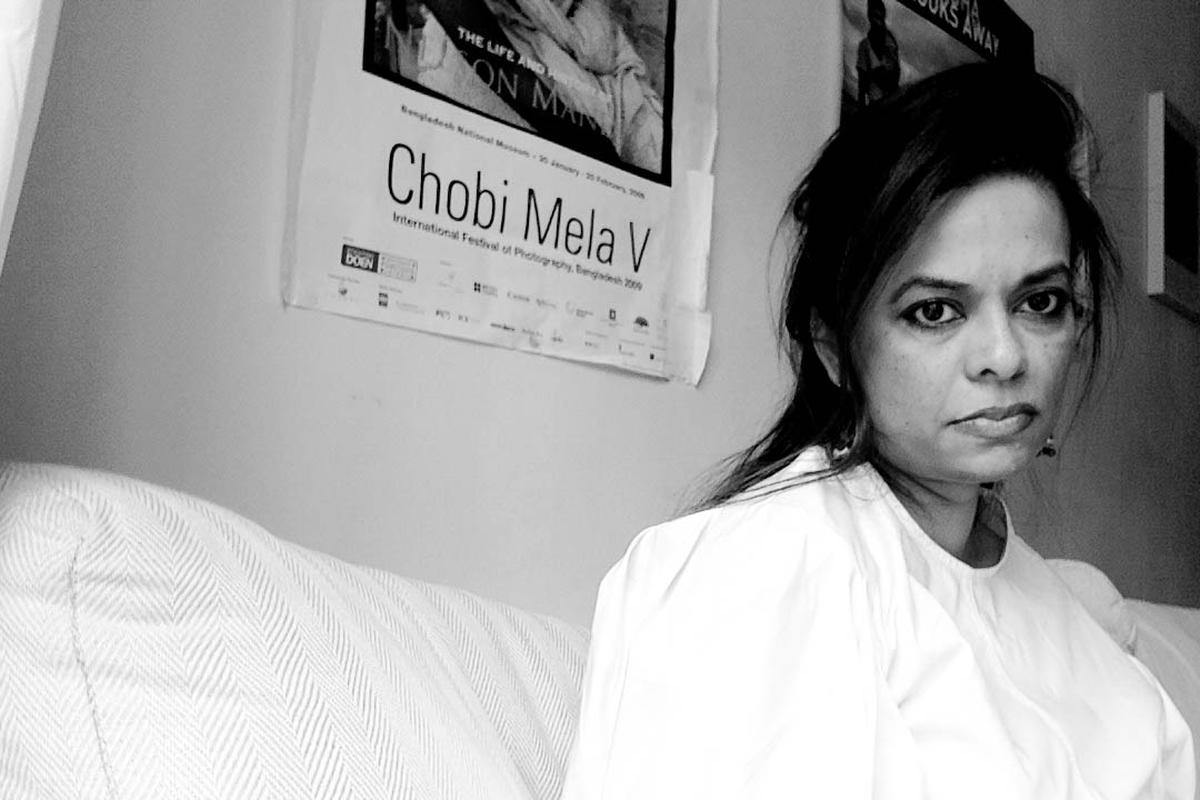
Sofia Karim
| Photo Credit:
Special arrangement
“When I was campaigning for him, I had to engage with this community of artists and activists that has been his world. Once I connected with them, the momentum built up. I began working with solidarity groups in the U.K. that have been active for the last 30 or more years, focusing on anti-racist and anti-imperialist movements, war on terror and Islamophobia. That’s when I realised that maybe art is a way to activate and vocalise some of the issues they face.”
Karim’s Turbine Bagh project, which takes after one of the biggest resistance movements in the world led by women, the 2019-2020 Shaheen Bagh protest in Delhi, was an urgent call to attention to the mass incarcerations in India and Bangladesh. Humble samosa packets became conduits carrying messages of dissent and the slogan ‘Free Shahidul’ across borders. The movement also took the form of a physical protest at Tate Modern’s Turbine Hall.
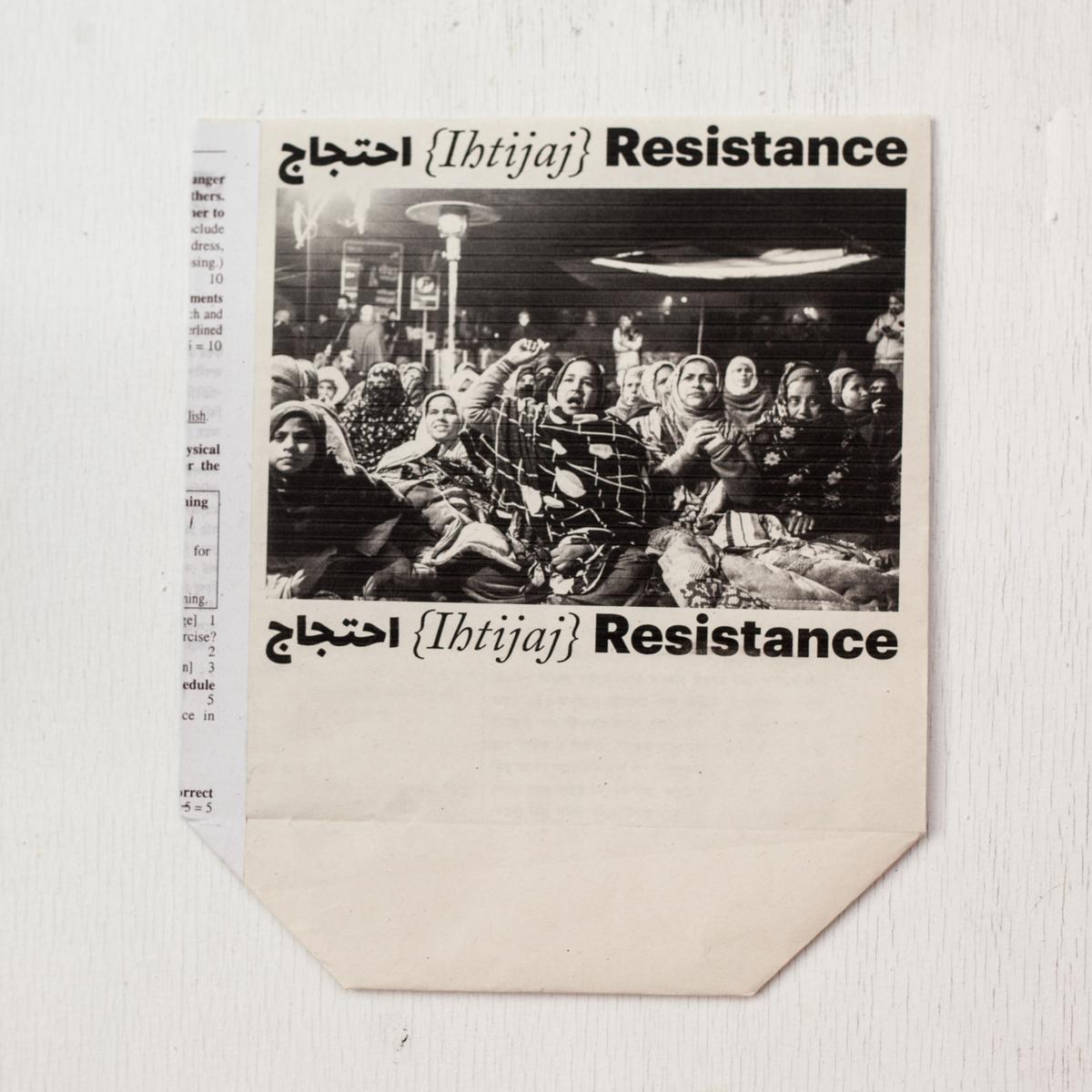
A samosa packet with a photograph by Ali Monis Naqvi from Shaheen Bagh
| Photo Credit:
Ali Monis Naqvi
Today, she is mobilising monetary support for the Palestine cause by offering to remodel bits and portions of homes in the U.K., the remunerations for which are used for donations. “We have done 11 or so projects, and some students have now got involved. It is also a way to bring activism into our architectural practice which is not done often,” says Karim, adding, “When you are an activist, one side of your work is very loud and direct in its messaging, and it needs to be. But most artists and activists have another side to them, where their work is a lot more quiet and inward.”
From the interstices
What sometimes goes amiss is the shared history of conflict areas that fall within geographical proximity. Bharatanatyam exponent Anita Ratnam says that there is a lot of art being created within these interstices, which is influenced by the idea of a fleeting life. “If you watch artists from Palestine or Israel or Lebanon, you can see the jagged edges in their work. Their bodies move in an accelerated frenzy and they have a very raw approach to their work. They are comfortable making audiences uncomfortable.”
She recalls a performance that happened in Chennai 20 years ago. “The Israeli embassy had sent us a celebrated solo artist, Rina Schenfeld. In one performance, she wore a hat made of barbed wire with a visor. That, she said, was inspired by the barbed wire fence at the Gaza Strip.” Part of her choreography had her moving in an agitated manner, without sound. Her body was emoting anguish. “That was what it seemed like when people were divided by the fence but were eager to connect. She took a political situation much older than October 7 and created a work of art.”
Archives of lived realities
While patronage for arts is already vexed, these difficulties are compounded in areas of conflict, believes documentary filmmaker and writer Sanjay Kak from Kashmir. “We all must share in those [responsibilities]. What artists are probably ordained to do is to perform the role of the avant-garde, and to find the crack in the brick wall, the chink in the armour. Open up the discourse, and look for ways of connecting old ideas and thinking up new ones,” he says.
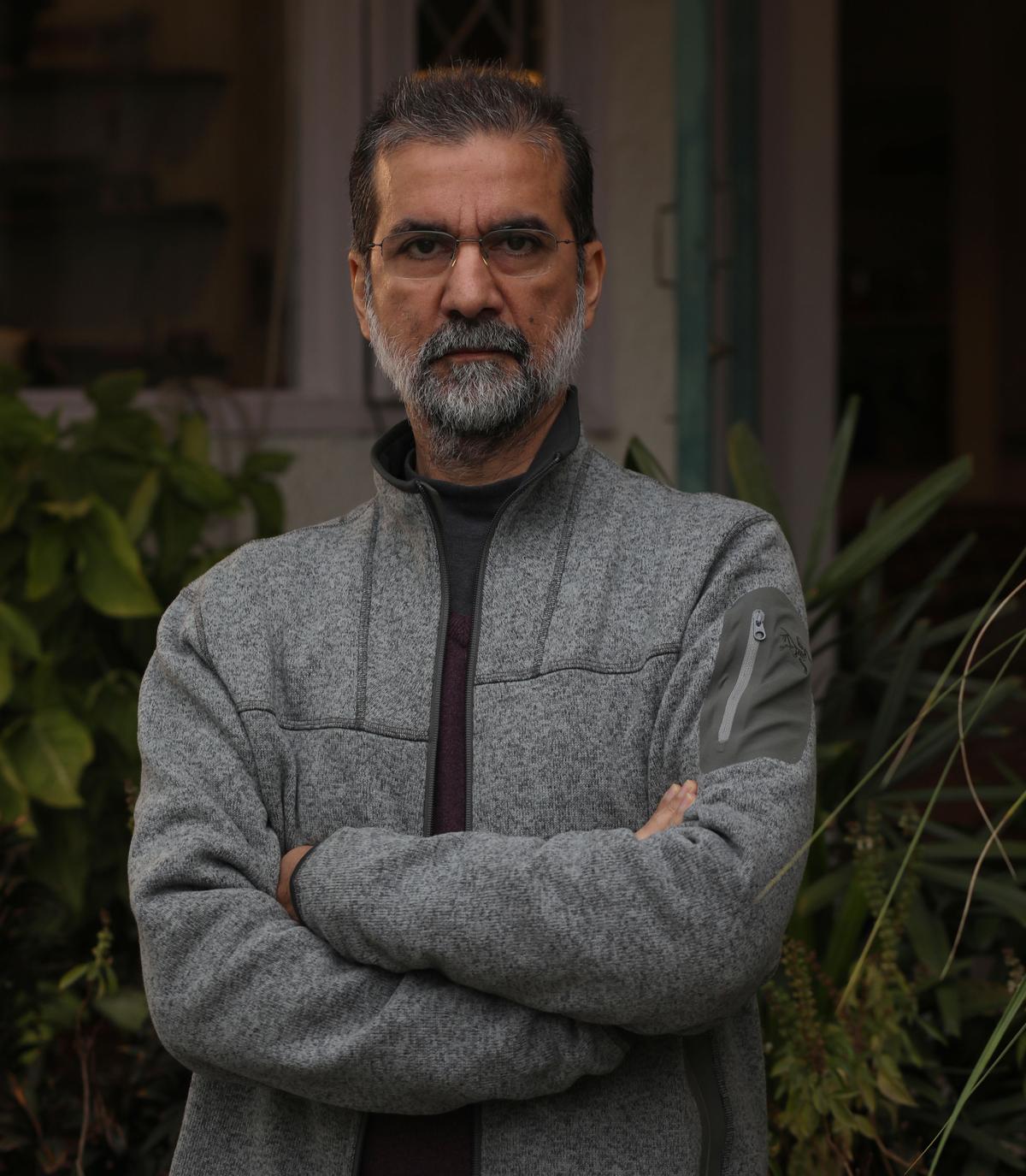
Sanjay Kak
| Photo Credit:
Special arrangement
The filmmaker’s curated book project, Witness, features the work of nine Kashmiri photographers (from 1986 to 2016) who stray away from the typified image of the valley that has gone through decades of unrest. “What the book also does is provide a model for a certain kind of collective effort. It’s not that the nine photographers were a group or will ever be one. But the generosity with which they shared their work for the book created a new thing, something that became visible as ‘Kashmiri photography’,” says Kak. The project, published in 2017, took on the job of an archive, with the sole aim to document the history of a conflict for posterity.
Police Announcement, Srinagar 2016, by photographer Syed Shariyar for Witness
| Photo Credit:
Syed Shariyar
In 2023, over 5,000 km away in Sudan, as intense fighting broke out in mid-April, capital city Khartoum, home to many art galleries and cultural museums, bore the brunt. Looting and vandalism were rampant. In June, Sudan National Museum was reportedly raided by the RSF fighters. Since then, there have been attempts to safeguard the cultural heritage of the nation, by artists and curators alike. In a project that identified almost 150 Sudanese artists who need rehabilitation, curators Raheim Shadad, Aza Satti and Mahsin Ismail started an online campaign to procure aid, and later sold art prints in Cairo to raise donations. Shadad also started an artists residency programme for refugees. The project helped some artists to relocate to other parts of the continent to continue their work.
Hope is not a constant emotion in stretched times. What has remained constant, however, is that even in the thick of adversities world over, artists continue to create. Back in Deir al-Balah, Baroud’s lines have become simpler and sharper. The details, textures and colour gradients that he once turned to are now absent in his work. Instead, he uses symbols with specific meanings: crescents, arrows, tulip flowers, tents and bodies. “Determination comes from not looking back and moving forward. I have vowed to myself to continue and try to survive as much as possible. I have decided to postpone my grief,” he states.
A call to build solidarity
At the intersection of artistic practice and social responsibility sits U.S.-based Pangea World Theatre. Thespians Dipankar Mukherjee and Meena Natarajan have been working towards the cause of decolonising practices and solidarity for almost three decades now. Through social justice arts, the theatre works with multiple minority cultures in Minneapolis, and centre their work around race, class and gender. Here, mediums of performance in the form of theatre, poetry and storytelling morph to help the community in tangible ways. One such project, ‘Poetry in the Windows’, highlighted small businesses that were affected by the pandemic by placing poems that encouraged people to express what the community felt.
The theatre was also at the forefront of the protests that followed the murder of George Floyd in 2020, which rekindled the Black Lives Matter movement across the United States. “The whole uprising was happening right in front of us,” recalls artistic director Mukherjee. “The police precinct that was burned down was just a mile away. There was no question of deliberating on what to do.”
Rehabilitation and healing becomes central to the conversation surrounding art and artists from conflict zones. A medium like theatre or narrative storytelling facilitates a deeper sense of healing. This is why Pangea hosts story circles that encourage displaced artists to share personal stories. “Let us take advantage of our privilege. We have tonnes of power,” says Mukherjee. “I don’t have to be a Palestinian to speak against the genocide. I don’t have to be a woman to speak against domestic violence. The call to build solidarity is immense now.” In 2023, under Mukherjee’s direction, Pangea produced Returning to Haifa based on the novella by Ghassan Kanafani that humanised stories of ordinary people as it explored the relationship between an Israeli family and a Palestinian couple caught in conflict.
gowri.s@thehindu.co.in
[ad_2]
Source link





